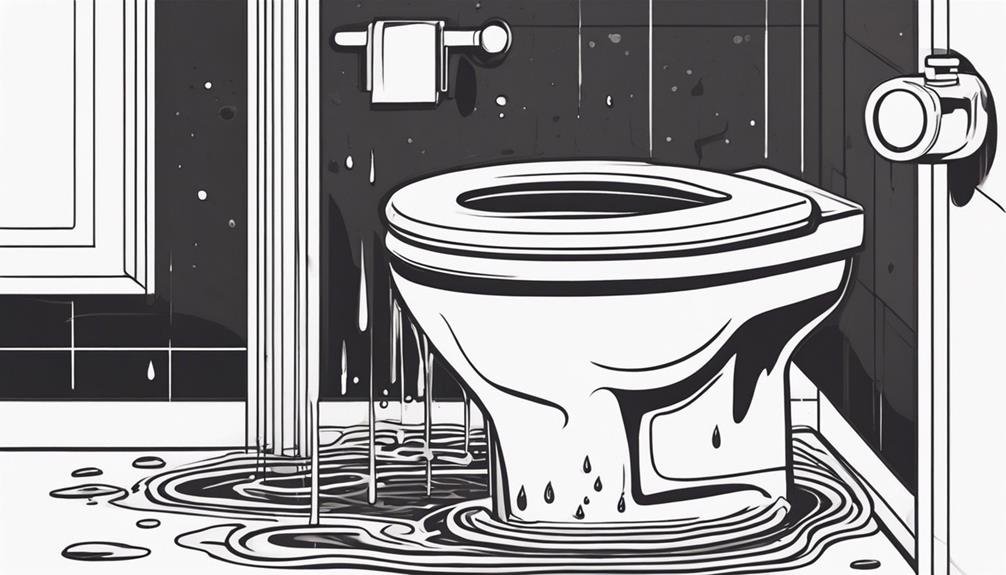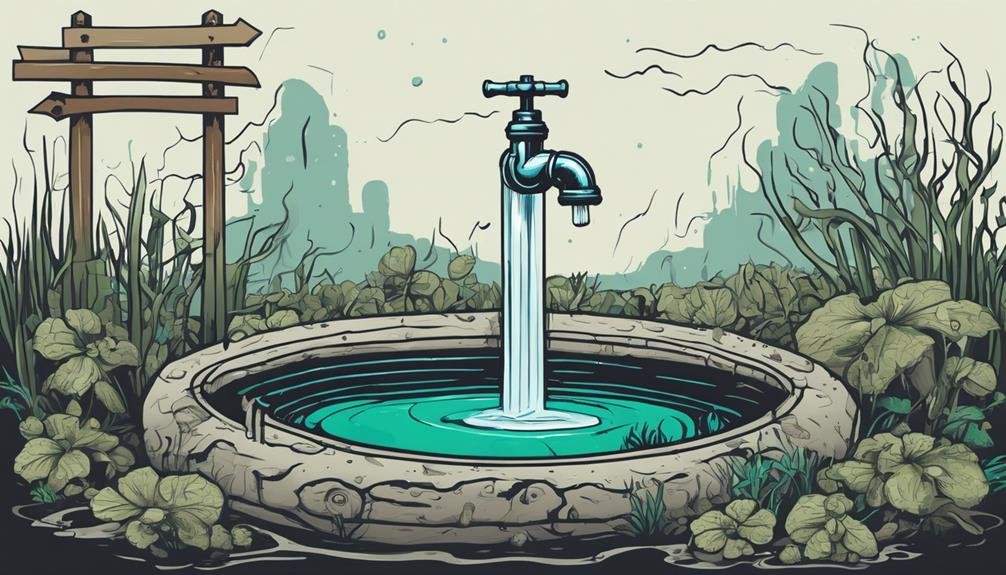Imagine your septic tank as a silent guardian beneath your property, diligently processing waste. But what if this guardian starts to show cracks in its armor?
Signs of an overflowing septic tank can be subtle at first, but they are crucial to catch early to prevent a messy and costly disaster.
Spotting these indicators could save you from a major headache down the line.
Key Takeaways
- Foul odors near the septic tank signal potential overflow.
- Slow drains and gurgling noises indicate septic system issues.
- Pooling water or lush grass around the tank suggests overflow.
- Sewage backups in fixtures are clear signs of septic tank problems.
Foul Odors Around Property

If you notice foul odors lingering around your property, it could be a warning sign of a septic tank overflow. Odors emanating from your septic system can be a result of gases like hydrogen sulfide, which have a distinct rotten egg smell. To address this issue, proper odor control measures need to be implemented. Start by ensuring that your septic tank is properly maintained. Regular inspection and pumping of the tank are crucial to prevent overflows and the accompanying foul smells.
Property maintenance plays a vital role in controlling odors from septic tanks. Make sure there are no leaks in the system, as these can release odorous gases into the air. Additionally, avoid planting trees near the septic tank or drain field to prevent roots from damaging the system, which could lead to leaks and odors. Proper ventilation around the tank area is also essential to disperse any gases that may cause unpleasant odors around your property. Regular maintenance and upkeep are key to effective odor control and maintaining a pleasant environment on your property.
Slow Draining Fixtures
To address slow draining fixtures effectively, inspect the plumbing system for potential blockages or clogs. Begin by checking all the affected fixtures like sinks, showers, and toilets. If multiple fixtures are draining slowly, the issue likely lies in the main drain line. Start by visually inspecting the pipes for any visible clogs or debris. Use a plumber's snake or auger to clear out any obstructions. For more stubborn clogs, consider using a drain-cleaning solution or contacting a professional plumber for assistance.
Regular plumbing inspection is crucial to prevent slow draining fixtures. Ensure that the drain field is properly maintained to avoid any septic system issues. Schedule routine checks to identify and address any plumbing issues promptly. Additionally, be mindful of what goes down your drains to prevent future blockages. Proper waste disposal practices can significantly reduce the likelihood of slow drainage in your fixtures.
Sewage Backing Up

If you start noticing foul odors indoors and slow draining fixtures, it might indicate a potential sewage backup issue. These signs are often early warnings that your septic tank might be reaching its capacity.
Addressing these indicators promptly can help prevent a messy and costly overflow situation.
Foul Odor Indoors
Indoor foul odors, particularly the smell of sewage backing up, can indicate a potential septic tank overflow issue. When you detect such odors inside your home, it's crucial to address the problem promptly to prevent further damage.
Here are some key points to consider:
- Check for Wet Areas: Look for wet spots or puddles near your plumbing fixtures as these can indicate sewage contamination.
- Listen for Gurgling Sounds: If you hear gurgling noises coming from drains, it may suggest a blockage in the septic system.
- Inspect Drain Speed: Slow drainage in sinks, showers, or toilets could be a sign of sewage backup and septic tank overflow.
Being proactive in addressing these warning signs can help you avoid costly repairs and maintain a healthy indoor air quality.
Slow Draining Fixtures
Are your sinks, showers, or toilets draining slowly, potentially indicating sewage backing up in your septic system? Slow drainage in fixtures can be a warning sign of a looming septic tank overflow. Preventive maintenance is crucial to avoid costly repairs.
To address slow draining fixtures, consider implementing drainage solutions. Start by ensuring that there are no clogs in the pipes leading to the septic tank. Regularly inspect and pump your septic tank as recommended to prevent solids from accumulating and causing blockages. Additionally, you can install drain filters to catch debris before it enters the system.
Taking these steps can help maintain proper septic system functioning and prevent sewage from backing up into your home.
Lush Green Grass Over Drain Field
Lush green grass over the drain field may indicate a potential septic tank overflow. When the septic system is overloaded, excess wastewater can flood the drain field, impacting the soil health and causing the grass to become unusually vibrant. This visual cue should prompt you to investigate further to prevent more serious issues.
Here are some key points to consider:
- Root Damage: The excess water from a septic tank overflow can drown the grass roots, leading to their decay and the eventual death of the grass above.
- Nutrient Imbalance: The imbalance caused by the overflow can lead to an overabundance of certain nutrients, resulting in the lush green appearance of the grass.
- Bacterial Contamination: An overflowing septic tank can introduce harmful bacteria to the soil, promoting excessive growth in some areas while inhibiting growth in others.
Monitoring the health of the grass above your drain field can provide crucial insights into the functioning of your septic system and help prevent potential overflows.
Gurgling Sounds From Plumbing

If you notice gurgling sounds coming from your plumbing, it could indicate a potential issue with your septic system. These noises may suggest that there's a blockage or backup in your pipes, causing air bubbles to escape as water tries to flow through.
To troubleshoot and address plumbing gurgles, it's essential to identify the root cause and address it promptly to prevent further septic tank problems.
Troubleshooting Gurgling Noises
When troubleshooting gurgling noises in your plumbing, it's crucial to identify the specific location and potential causes behind these unsettling sounds. Gurgling sounds may indicate air trapped in the pipes, leading to issues within your plumbing system. To pinpoint the source of the gurgles, consider the following:
- Improper Venting: Inadequate venting can cause air to get trapped in the pipes, resulting in gurgling noises.
- Partial Blockages: Partial blockages due to debris or buildup can disrupt the flow of water, leading to gurgling sounds as air passes through.
- High Water Usage: Excessive water usage, such as filling a bathtub or using a bubble bath, may overwhelm the system and contribute to gurgling.
Identifying and addressing these issues promptly can help prevent more significant plumbing problems.
Fixing Plumbing Gurgles
To address plumbing gurgles, investigate potential causes behind the unsettling sounds to effectively resolve the issue. Gurgling in your plumbing can often indicate a problem with your pipes or drains.
Start by checking for any clogs in your drains; debris accumulation can lead to air bubbles causing the gurgling noise. If the issue persists, inspect your pipes for damage or leaks. Pipe repair may be necessary to eliminate the gurgling.
Additionally, regular drain maintenance is crucial to prevent buildup and blockages that can contribute to the noise. Consider using drain cleaners or a plumber's snake to keep your drains clear and prevent gurgling in the future.
Soggy Ground Near Tank
Near your septic tank, be vigilant for areas of excessively wet or soggy ground, as this could indicate a potential septic tank overflow issue. When you notice soggy ground near your tank, it's crucial to address the problem promptly to prevent further damage. Here are some key points to consider:
- Inspect the Drainage: Check if there are any issues with the drainage system around your septic tank. Poor drainage can lead to water pooling around the tank, causing the ground to become soggy.
- Monitor Water Usage: Keep an eye on your water consumption habits and look for any sudden spikes in water usage. Excessive water usage can overload the septic system, leading to overflow and soggy ground.
- Consider Water Conservation: Implement water conservation practices in your household to reduce the strain on your septic tank. This can help prevent future overflow issues and keep the ground around your tank dry and stable.
High Levels of Nitrate in Well Water

Regularly test your well water for nitrate levels to ensure it meets safety standards and avoid potential health risks. Nitrate contamination in well water can occur due to various sources such as agricultural runoff, septic system leakage, or wastewater discharge. High levels of nitrates in drinking water pose significant health risks, especially for infants and pregnant women, as nitrates can interfere with the blood's ability to carry oxygen, leading to a condition called methemoglobinemia or 'blue baby syndrome.'
To safeguard against nitrate contamination, it's crucial to conduct routine water testing. Prevention strategies include maintaining a safe distance between septic tanks and wells, proper septic system maintenance, and avoiding the excessive use of fertilizers near water sources. If elevated nitrate levels are detected in your well water, consider installing a water treatment system to remove nitrates effectively. By staying vigilant and taking proactive measures, you can ensure the safety and quality of your drinking water.
Conclusion
If you notice any of these warning signs of septic tank overflow, it's crucial to address the issue immediately to prevent a messy and costly disaster.
Just like a ticking time bomb, an overflowing septic tank can wreak havoc on your property and health.
Don't ignore the signs – take action to avoid a sewage nightmare.

